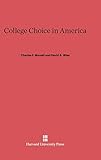College Choice in America / Charles F. Manski, David A. Wise.
Material type: TextPublisher: Cambridge, MA : Harvard University Press, [2013]Copyright date: ©1983Edition: Reprint 2014Description: 1 online resource (221 p.) : illustrationsContent type:
TextPublisher: Cambridge, MA : Harvard University Press, [2013]Copyright date: ©1983Edition: Reprint 2014Description: 1 online resource (221 p.) : illustrationsContent type: - 9780674422278
- 9780674422285
- Berufswahl
- College choice
- College
- Erziehung, Schul- und Bildungswesen
- Etats-Unis
- Etudiant
- High school
- Hoger onderwijs
- Schulabgänger
- Schulabgänger
- Sociologie de l'éducation
- Sociologie de l'éducation
- Studiekeuze
- Université
- Universities and colleges
- Université
- College choice
- EDUCATION / General
- SOCIAL SCIENCE / Sociology / General
- Universities and colleges -- United States
- EDUCATION / General
- 378/.198
- LB2350.5
- online - DeGruyter
| Item type | Current library | Call number | URL | Status | Notes | Barcode | |
|---|---|---|---|---|---|---|---|
 eBook
eBook
|
Biblioteca "Angelicum" Pont. Univ. S.Tommaso d'Aquino Nuvola online | online - DeGruyter (Browse shelf(Opens below)) | Online access | Not for loan (Accesso limitato) | Accesso per gli utenti autorizzati / Access for authorized users | (dgr)9780674422285 |
Frontmatter -- Acknowledgments -- Contents -- Introduction -- 1. Overall Findings -- 2. Econometric Modeling of Student Behavior -- 3. From High School Graduation to School and Work -- 4. Application and Admission -- 5. The Allocation of Discretionary Grant Aid -- 6. Selecting a Postsecondary School -- 7. Enrollment Effects of the BEOG Program -- 8. College Attendance versus College Completion -- Conclusion -- Appendixes, Notes, References, Index, -- APPENDIX -- Notes -- References -- Index
restricted access online access with authorization star
http://purl.org/coar/access_right/c_16ec
The most crucial choice a high school graduate makes is whether to attend college or to go to work. Here is the most sophisticated study of the complexities behind that decision. Based on a unique data set of nearly 23,000 seniors from more than 1,300 high schools who were tracked over several years, the book treats the following questions in detail: Who goes to college? Does low family income prevent some young people from enrolling, or does scholarship aid offset financial need? How important are scholastic aptitude scores, high school class rank, race, and socioeconomic background in determining college applications and admissions? Do test scores predict success in higher education? Using the data from the National Longitudinal Study of the Class of 1972, the authors present a set of interrelated analyses of student and institutional behavior, each focused on a particular aspect of the process of choosing and being chosen by a college. Among their interesting findings: most high school graduates would be admitted to some four-year college of average quality, were they to apply; applicants do not necessarily prefer the highest-quality school; high school class rank and SAT scores are equally important in college admissions; federal scholarship aid has had only a small effect on enrollments at four-year colleges but a much stronger effect on attendance at two-year colleges; the attention paid to SAT scores in admissions is commensurate with the power of the scores in predicting persistence to a degree. This clearly written book is an important source of information on a perpetually interesting topic.
Mode of access: Internet via World Wide Web.
In English.
Description based on online resource; title from PDF title page (publisher's Web site, viewed 29. Nov 2021)


